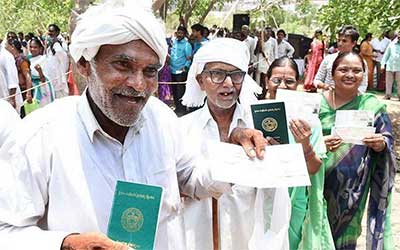Relevance: GS-3: Issues related to Direct and Indirect Farm Subsidies and Minimum Support Prices;
Key phrases: Rythu bandhu, PM KISAN, DBT
Why in news?
- Rythu Bandhu disburses 50k crore since 2018
Analysis:
What is Rythu Bandhu Scheme?
- A DBT scheme of Telangana government for landowning farmers
- State government extends financial support to land-owning farmers at the beginning of the crop season through direct benefit transfer so that they can take care of the initial investment needs and do not fall into a debt trap.
- Each farmer gets Rs 5,000 per acre per crop season without any ceiling on the number of acres
What is PM KISAN?
- Programme to provide an assured income support to the small and marginal farmers. Vulnerable landholding farmer families, having cultivable land up to 2 hectares, will be provided direct income support at the rate of Rs 6,000 per year
- It’s a scheme by central government and doesn’t include landless laborers just like Rythu bandhu
Why do we need these DBT schemes?
- Declining prices of agricultural commodities in the international market and fall in food inflation in India since 2017-18, relative to non-food sector, therefore reduced the returns from farming.
- To increase the income of farmers as small and fragmented land holdings and their further divisions has contributed in declined income.
- To provide structured income support for procuring inputs such as seeds, fertilisers, equipment, labour and other needs.
- This component is not linked to extent of land owned and will greatly benefit share croppers and actual cultivators most of whom own very small extent of land.
- Scheme would act as a strong consumption stimulus that will help in economic growth especially due to ongoing slower economic growth due to decreased rural demand.
- PM-KISAN would help in reducing poverty, ensure sustainable food security, and inclusive growth and wellbeing of farmers. The farmers will have complete independence to take up interventions as per their needs.
- This will encourage greater usage of bank accounts, leading to higher profits for banking correspondents (BC) and an endogenous improvement in financial inclusion.
Challenges with such schemes
- Difficulty in Identifying Beneficiary Farmers: Land holding does not determine the number of farmer families present in the country as there are multiple owners for a single land or a single owner for multiple landholding
- There are reports that several bank branches adjusted the deposit money against past liabilities of few farmers
- Neglect of lessee cultivators: Benefits accruing to lessee cultivators or share- croppers under PM-KISAN or Rythu bandhu have not been explicitly mentioned. Also, identification of these lessee cultivators continues to be challenge
- Lack of grievance redressal mechanism: Scheme does not provide a clear design of transfers and a framework for effective grievance redress.
Current status of farmers in India
- Small marginal farmers with less than two hectares of land account for 86.2 % but own only 47.3 percent of the crop area. This does not allow for surpluses that can financially sustain families
- As per agricultural census 73% of rural women are engaged in farming but only 12% own landholdings-83% of India’s agricultural land is owned by men
- Limited efficacy of crop insurance schemes in India: Currently, only about 35 % of farmers are covered under crop insurance schemes
- Only about 10% of the agricultural land is under tenancy, down from 20% in 1953-54-NSSO 2012-however believed to be under reported
- Size of the average land holding has been declining in India (the average landholding size of a household is only 1.1 hectare (ha) in 2015-16, according to a survey by NABARD
Way ahead
- Strengthening IT backbone: States with robust IT infrastructure will be in a better position to implement PMKISAN.
- Targeting updating of land records: It will ensure that eligible cases are not deprived. Similarly, fraudulent claims will also be avoided
- Focus on other reforms: Any income support scheme can’t cover all the farm households and therefore, enhancing investments in rural infrastructure (roads, irrigation, market) and agricultural R&D will be helpful
Source: Indian Express







